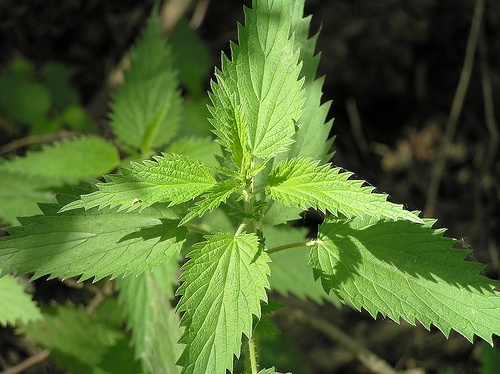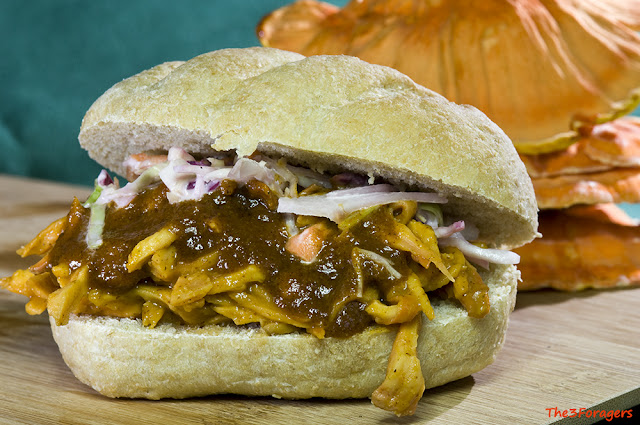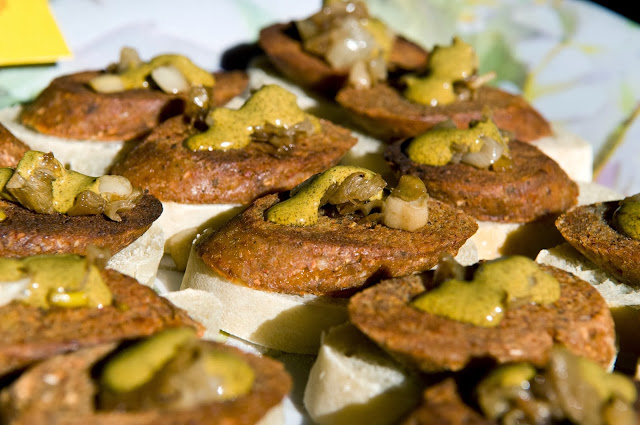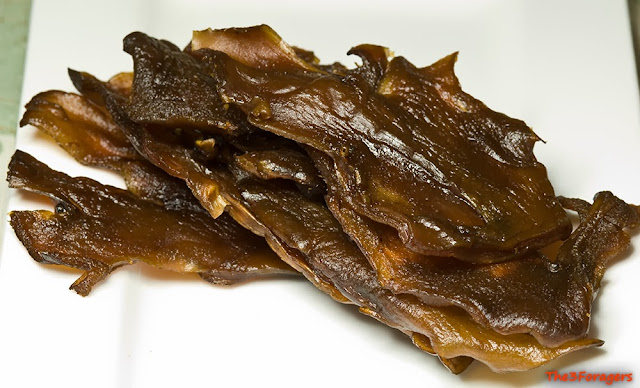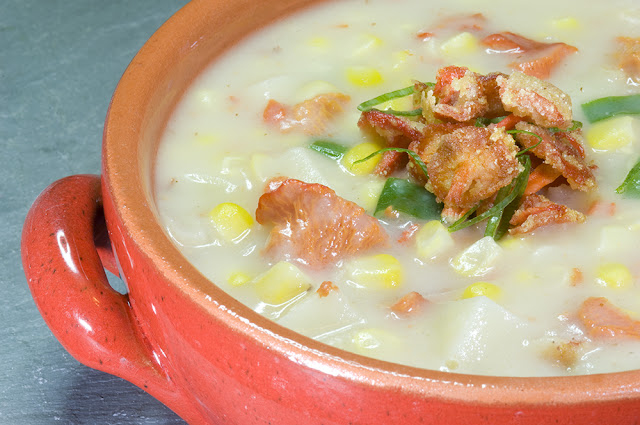As promised ... Kudzu recipes galore. I've gathered these recipes from all over and have tried every one of them. Some went over better than others with the family. But I don't get to do it as much as there is no kudzu growing naturally around my primary location and I'm not about to plant a patch and start it up. I'm crazy, not insane. LOL. One of these days kudzu is going to take over the earth.
Kudzu Blossom Jelly
Spoon over cream cheese, or melt and serve over waffles and ice cream. The blossom liquid is gray until lemon juice is added.
4 cups Kudzu blossoms
4 cups boiling water
1 tablespoon lemon juice
1 (1 3/4-ounce) package powered pectin
5 cups sugar
Wash Kudzu blossoms with cold water, and place them in a large bowl. Pour 4 cups boiling water over blossoms, and refrigerate 8 hours or overnight. Pour blossoms and liquid through a colander into a Dutch oven, discarding blossoms. Add lemon juice and pectin; bring to a full rolling boil over high heat, stirring constantly. Stir in sugar; return to a full rolling boil, and boil, stirring constantly, 1 minute. Remove from heat; skim off foam with a spoon. Quickly pour jelly into hot, sterilized jars, filling to 1/4 inch from top. Wipe jar rims. Cover at once with metal lids, and screw on bands. Process in boiling water bath 5 minutes. Cool on wire racks. YIELD: 6 half pints.
________________________________________
Rolled Kudzu Leaves
Kudzu Leaves
1 can diced tomatoes
2 teaspoons salt
3 cloves garlic, cut in half
Juice of 3 lemons
Bacon Grease (optional)
Stuffing ingredients: 1 cup rice, rinsed in water
1 pound ground lamb or lean beef
1 cup canned diced tomatoes
1/2 teaspoon of allspice
Salt and Pepper to taste
Gather about 30 medium-sized young kudzu leaves. Make sure area has not been sprayed with chemicals to kill the Kudzu. Wash leaves. Drop into salted boiling water. Boil a 2-3 minutes, separating leaves. Remove to a plate to cool. Remove heavy center stems from the leaves by using a knife and cutting down each side of the stem to about the middle of the leaf. Combine all stuffing ingredients and mix well. Push cut sides together and fill with 1 teaspoon stuffing and roll in the shape of a cigar. Place something in bottom of a large pan so that rolled leaves will not sit directly on the bottom of the pan. Bacon grease is great for seasoning.
Arrange Kudzu rolls alternately in opposite directions. When all are in the pot, pour in a can diced tomatoes, 2 teaspoons of salt, and 3 cloves of garlic, cut in half. Press down with an inverted dish and add water to reach dish. Cover pot and cook on medium for 30 minutes. Add lemon juice and cook 10 minutes more.
________________________________________
Kudzu Quiche
Makes 4-6 servings.
1 cup heavy cream
3 eggs, beaten
1 cup chopped, young, tender Kudzu leaves and stems
1/2 teaspoon salt
Ground pepper to taste
1 cup grated mozzarella cheese
1 nine-inch unbaked pie shell
Preheat oven to 350 degrees. Mix cream, eggs, kudzu, salt, pepper, and cheese. Place in pie shell. Bake for 35 to 45 minutes until center is set.
________________________________________
Kudzu Tea
Kudzu leaves
Mint
Honey
Simmer 1 cup of finely chopped Kudzu leaves in a quart of water for 30 minutes. Drain and serve with honey and a sprig of mint. If you prefer a sweeter taste use honey to sweeten the tea.
________________________________________
Deep Fried Kudzu Leaves
Pick light green leaves, 2-inch size.
Thin batter made with iced water and flour
Oil
Heat oil. Rinse and dry kudzu leaves, then dip in batter (chilled). Fry oil quickly on both sides until brown. Drain on paper toweling. Eat while warm.
________________________________________
Kudzu Leaves and Vine Tips
In the early spring and throughout the growing season, harvest the very end of an established kudzu vine where the new growth is forming small shoots and young leaves (called runners). Only the young leaves and vine tips are tender enough for human consumption. The older leaves and vines are too tough for the human digestive system. Wash the kudzu thoroughly in cool water. Then soak the kudzu for 20 minutes in some clean cool water with a little salt added. Rinse and drain. Process immediately or store in the refrigerator for 3 to 4 days in an airtight container. Kudzu leaves have a soft fuzz on them. The fuzz is offensive to most people when eaten raw. The fuzz wilts quickly when cooked. Therefore, briefly dip the fresh leaves in some boiling water and then immediately dip in cold water. The fuzz will wilt, the appearance of the leaves will change, but the taste will not have changed.
________________________________________
Kudzu Leaf Recipes
Kudzu leaves and tender vine tips may be boiled the same way you boil spinach.
Boiled kudzu leaves mix well with other cooked greens including spinach and young poke sallet leaves. (Note: Young poke sallet leaves must be boiled three times in clean water prior to eating.)
Boiled kudzu leaves blend well with cooked rice and many cooked wild meats.
Fresh kudzu leaves may be processed in a pressure cooker following a spinach canning recipe, and stored in canning jars for future consumption.
________________________________________
Kudzu Flower Blossoms
Kudzu blooms from late July through September, depending on the climate and location. The most common species in the United States has magenta and reddish purple flowers that resemble a wisteria. A less common variety has white blossoms.
Kudzu flowers smell like ripe grapes. However, the blossoms do NOT taste like grapes. They have a unique flavor that is just a little bit sweet.
The flowers are sometimes hidden behind the green leaves. Pick the flowers when they are dry (not covered with the morning dew or rain). You may just pick the flowers, but it is usually easier to cut the entire flower raceme of blossoms and then remove the individual flowers later. Wash the flowers gently but thoroughly in cool water and then drain. They will remain fresh for one day. Or freeze them for future consumption.
________________________________________
Kudzu Flower Salad
Kudzu flowers may be eaten plain or as part of a salad or other dish.
________________________________________
Kudzu Flower Tea
Pour a cup of boiling water over 1/4 cup fresh flowers and let it steep for 4 or 5 minutes. Strain and drink.
________________________________________
Kudzu Flower Wine
4 quarts well water
6 quarts fresh kudzu blossoms
yeast
4 cups sugar
1 gallon jug
1 balloon
Pick kudzu blossoms when they are dry (mid-day). Rinse in running water to remove any foreign particles, dirt, or dust. Pour three quarts of boiling water over the blossoms and stir. Put a lid on the container and stir twice a day for four days. Strain the liquid through a clean cloth. Press the blossoms to get all the liquid from them. Add four cups sugar. Dissolve yeast in lukewarm water. Pour the dissolved yeast into the liquid. Stir well. Cover and let it stand for five days. Then transfer to a one-gallon jug. Add enough well water to bring the liquid within two inches below the neck of the jug. Attach the balloon to the top of the jug. Place jug in a cool dark place that is between 65° F to 75° F. Periodically gently loosen the balloon and allow the gas to escape and then replace the balloon firmly on the neck of the jug. In approximately six weeks the balloon will stop expanding and the wine is done. Strain the wine through a clean cloth and transfer it to airtight bottles. (Optional: Drop five raisins into each one-gallon bottle.) Cork each bottle tightly. Allow it to sit for an additional six to twelve months before drinking.
________________________________________
Kudzu Roots
Kudzu roots are normally harvested in the winter months. Only a kudzu root that was started from a seedling will produce a root that contains a good quantity and quality of starch. Good kudzu starch roots may weigh up to 200 pounds and be as long as 8 feet. The vast majority of kudzu roots are formed when an established vine touches the ground. Most of the roots growing near the surface are NOT high quality. Most kudzu roots look like tree roots and are NOT edible.
________________________________________
Kudzu Root Sucker
In a survival situation, any kudzu root between 1/2 to 3/4 inches in diameter can be washed, cut at both ends to a length of about 6 inches, and then all the exterior bark should be scrapped off. The raw root can then be sucked on to gradually remove all its internal nutrients. Only suck the nutrients out of the root. The root is wood. Wood is NOT digestible. Do NOT eat the wood.
________________________________________
Kudzu Root Tea
The thin, tender young roots can be dug up, washed, diced, boiled, and strained to make a tea.
________________________________________
Pork Tenderloin with Kudzu Salsa
Yield: 4 servings
½ cup soy sauce
1 tablespoon sesame oil
2 teaspoons teriyaki sauce
2 garlic cloves, minced
1 teaspoon ground ginger
1 pound pork tenderloin
½ teaspoon oregano
½ teaspoon cumin
¼ cup honey
2 tablespoons brown sugar
Kudzu salsa:
1 cup diced freshly boiled Kudzu stems
1 large tomato, diced
1 tablespoon minced red onion
1 teaspoon olive oil
¼ teaspoon salt
2 tablespoons honey
1 tablespoon cilantro
1 tablespoon lime juice
Combine first 5 ingredients in a large shallow dish or heavy-duty zip-top plastic bag. Add pork. Seal and chill 6-8 hours; Remove pork from marinade, discarding marinade. Sprinkle with oregano and cumin; Stir together honey and brown sugar. Brush pork with honey mixture; place on greased rack in roasting pan; Bake at 400 degrees 25-30 minutes or until thermometer reaches 160 degrees. Cut pork into slices; serve with Kudzu salsa; To prepare salsa, combine all ingredients, cover and chill until ready to serve.
________________________________________
Kudzu Flower Jelly
4 half-pints
4 cups kudzu blossoms
4 cups boiling water
1 tablespoon lemon juice
1 package pectin
5 cups sugar
Put washed blossoms in bowl. Pour boiling water over blossoms, stir and set in refrigerator 6 hours or overnight. Strain and put liquid in a medium pot. Liquid will be brown. Add lemon juice and pectin. Bring to a full rolling boil, stirring constantly. Allow to boil 2 minutes. Skim foam. Then pour into sterilized jars and seal. Process jelly in boiling water bath for 7 more minutes.
________________________________________
Fruit Juice Jelled Kudzu Desserts
Yield: 2 servings
1 cup fruit juice
2 tablespoons kudzu starch
Combine juice and kudzu powder in a saucepan, whisking until powder is dissolved. Bring to a boil. Simmer, stirring constantly for 1-2 minutes, or until transparent and well thickened. Pour into moistened individual cups and cool. Serve chilled.
________________________________________
Kudzu-Rice Quiche
Yield: 6 servings
4 eggs
2 cups cooked rice
½ cup finely grated Swiss cheese
½ pound fresh, young kudzu leaves
2 tablespoons butter or margarine
½ teaspoon salt
1 cup cottage cheese
¼ cup grated Parmesan
6 tablespoons heavy cream or evaporated milk
¼ teaspoon nutmeg
6 drops hot sauce
Preheat oven to 350 degrees. Grease a 9-inch pie pan or use an 8- or 9-inch square cake pan. In a medium bowl, beat 1 egg. Add rice and Swiss cheese. Stir well. Spread mixture evenly in prepared pan, making a crust. Refrigerate until ready to fill and bake. Cook kudzu leaves in a small amount of water, press to remove moisture and chop fine. Add butter and set aside. In a medium bowl, beat remaining 3 eggs. Stir in salt, cottage cheese, Parmesan cheese, heavy cream, hot sauce and nutmeg. When it's blended, stir in Kudzu. Pour into prepared rice crust. Bake 30-35 minutes or until firm.
________________________________________
Dried Kudzu
Dry only the smallest leaves. Place them between paper towels to absorb the moisture and microwave for 30 seconds, then flip. Continue microwaving and flipping until dry. Leaves are easy to burn, so watch carefully. Crumbled leaves can be used in your favorite bread or pasta recipes. Freeze them for longer storage.
________________________________________
Kudzu Candy
Melt almond bark or flavored candy melts from a craft store in a double boiler. Add raisins, nuts and crushed, dried kudzu leaves. Spread on a cookie sheet; let cool completely and then break into pieces. Or pour candy into molds and cool completely.
________________________________________
Kudzu Blossoms
To make jelly, pour hot water over blossoms. Let stand overnight; strain through cheesecloth. Do not freeze liquid; it will change color. Liquid may be canned in sterilized jars.
________________________________________
Kudzu Blossoms Note
I make kudzu jelly and was just cruising the net looking at other's recipes. I noticed that it said not to freeze the juice. For years, I have frozen the juice, yes it turns the color of a grape popsicle but when thawed it returns to its original color and makes great jelly so this is a great alternative for picking in the hot summer and making the jelly in the fall and winter when things cool off a bit. Just thought I'd share that with you. Lisa
________________________________________
Kudzu Leaves with Sesame Dressing
Boil young leaves, wrap in a cotton dishcloth and press with several pounds of weight for 10 minutes. Dice fine and dress with a mixture of 2 tablespoons tahini (or substitute sesame or peanut butter creamed with 1 teaspoon water). 1-1/2 tablespoons vinegar, 1 teaspoon honey, and 1/2 teaspoon salt (or 1-1/2 teaspoons natural soy sauce).
________________________________________
Steamed Roots
Since ancient times, kudzu roots have been used in Japan as, an emergency food in times of famine. Gathered during the fall or winter, when they are rich in starch, they are cut into cubes, steamed or boiled, and served seasoned with natural soy sauce, miso, or salt.
________________________________________
Kudzu powder may be substituted for flour, arrowroot, or cornstarch as a thickening agent in most recipes. Use the following proportions:
1 teaspoon kudzu powder = 3 teaspoons flour
1-1/2 teaspoons kudzu powder = 3 teaspoons arrowroot
4-1/2 teaspoons kudzu powder = 3 teaspoons cornstarch
Acidic liquids such as lemon juice require 10 to 15 percent more kudzu powder for thickening or jelling than water or alkaline liquids such as apple juice.
Dissolving Kudzu Powder: Combine the powder and cold liquid in a small bowl or cup. Stir well, then mash any remaining lumps with fingertips. Pour through a small, fine-mesh strainer into cooking liquid, retrieving all kudzu from bowl with a rubber spatula. Dip strainer in cooking liquid to rinse.
________________________________________
Apple Pie with Kudzu-Apple Juice Glaze
This old-fashioned pie with its opalescent glaze contains no sweetener, yet has its own delicious natural sweetness and delicate texture. The glaze also does nicely atop any of your favorite fruit or vegetable pies (onion, kabocha, or pumpkin are especially good) as well as tortes and cheesecakes.
1/2 cup whole wheat flour
3/4 cup unbleached white flour
1/4 teaspoon salt
3 tablespoons (sesame) oil
1/3 cup water
1/2 egg white (optional)
4 (pippin) apples, thinly sliced
1-1/3 cups apple juice
1/3 cup raisins
1/2 teaspoon cinnamon
1/2 teaspoon lemon juice
2 tablespoons kudzu powder
Preheat oven to 400° F. Combine flours and salt, mixing well. Add oil and rub mixture gently between palms to blend evenly. Gradually add water to form a dough and knead for 2 minutes, or just until smooth. Roll out round on a floured board and use to line a nine-inch pie plate. Flute edges, prick bottom with a fork, and brush, if desired, with egg white. Bake for 30 minutes, or until nicely browned. While crust is baking, combine apples, 1/3 cup apple juice, and raisins in a saucepan and bring to a boil. Cover and simmer for 15 minutes. Mix in 1/4 teaspoon cinnamon and lemon juice, remove from heat, and allow to cool. While apples are simmering, combine kudzu powder and the remaining 1 cup apple juice in a small saucepan, stir until dissolved, and bring to a boil. Simmer for about 1 minute, or until transparent and nicely thickened. Spoon cooked apples into baked crust and smooth surface. Pour kudzu glaze evenly over the top, then allow to cool to room temperature. Cover and refrigerate. Serve chilled, topped with a sprinkling of cinnamon.
